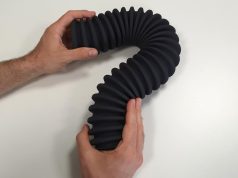Active quality assurance is one of the most important requirements of additive production users. Monitoring the key data of a laser melting system regarding oxygen content, temperature, laser output and powder quality is part and parcel of the standards nowadays. However, a comprehensive statement about the quality of the part cannot be made simply on the basis of these machine parameters. Using in-situ process monitoring systems based on an on-axis system, however, it is possible to obtain information about defects during the build process. Concept Laser, a pioneer of LaserCUSING, now presents a tool for position-related real-time monitoring and three-dimensional visualization. The next quality level with QMmeltpool 3D will be available from 2016 onwards for the M1 cusing and M2 cusing machines.
In-situ process monitoring is one of the strategic technology areas of Concept Laser, and is one which the machine manufacturer is now expanding to include the QMmeltpool 3D for three-dimensional real-time monitoring. The LaserCUSING process is a highly dynamic one because of the high scanning speeds and significant laser outputs; it is influenced by a wide variety of process factors. In challenging areas such as medical technology, automotive as well as aerospace, the safety requirements are strict and high quality is a prerequisite. QMmeltpool 3D supplies quality-relevant data in real time for process monitoring and documentation. The system records position-related characteristics of the melt pool while the component is being built up (Figure 3). This data can be visualized in a three-dimensional landscape, and analyzed by the user. According to information from the manufacturer, the analytical tool is comparable to the HD resolution achieved by computer tomography (CT).

Process monitoring with QMmeltpool
The QMmeltpool system uses coaxial sensors to detect melt pool emissions that are created during the fusing process in the form infrared radiation. The coaxial structure allows restriction to a small region of interest with a high local resolution and rapid scanning rates (up to 50 kHz, depending on the detector type). This melt pool monitoring identifies two characteristic parameters: The melt pool area and melt pool intensity. These characteristic parameters can be allocated to corresponding process errors. For example, a low melt pool intensity may indicate inadequate laser output or an excessively high scanning speed, i.e. insufficient energy input. Moreover, changes in the area of the melt pool may indicate a variation in the oxygen content within the process chamber. The part geometry also has effects on the thermal conditions in the process, which means that reference samples and a high level of process understanding are required for the variation in data during the process to be interpreted and analyzed correctly. In 2D melt pool monitoring, the signals are supplied as average values per component and per layer. This 2D perspective permits a restricted interpretation of localized defects.
QMmeltpool becomes QMmeltpool 3D
The former time-related 2D monitoring of the build process has now become a position-related 3-D landscape. Instead of exclusively time-related data, the system now additionally delivers position-related signals for definitive allocation, comparable to computer tomography (CT) (Figure 3). These signals make it possible to generate 3D datasets of the part or its structure. A highly accurate 3-D landscape of the part is thus created. In detail, this means identifying characteristic properties of the melt pool. These include the area and intensity of the melt pool that can be investigated using two detectors, a camera and a photodiode, with a high resolution level in terms of location and timing. Following that, these signals are correlated with the corresponding positional data of the laser. This comparison is what makes QMmeltpool 3D so ingenious: melt pools signals such as melt pool area and melt pool intensity can thus be visualized and evaluated in three-dimensions directly after the build process has finished. The user can trace the process of creating each part in terms of position. Local effects in the part during the build process can now be detected and analyzed better.

Coaxial integration with QMmeltpool 3D: pinpoint accuracy with the on-axis approach
The new approach is based on expanding the 2-D inspection into the 3-D space, with coordinate-related data acquisition of the melt pool values. It is possible to look at current quality assurance approaches available on the market to assess the new method of QMmeltpool 3D. Classic off-axis inspections have a lower resolution and lower detection rate. For example, an infrared-sensitive camera is used located in a position outside the build chamber – i.e. ex situ (Figure 2). The advantage of this ex-situ solution is that the system integration of the machine and camera system is rendered straightforward. An off-axis structure enables statements to be made about the overall fusing and cooling behavior. However, it is not possible to derive a detailed statement about the melt pool. The on-axis/in-situ structure is based on a two axial arrangement of detectors (Figure 1).

The detectors used are a camera and a photodiode which use the same optic as the laser. This coaxial integration permits a high coordinate-related 3D resolution of 35 µm. The detection rate results from the scanning speed. If it is 1,000 mm/s, the result is 100 µm, i.e. the distance covered by each shot. At 2,000 mm/s, the value is 200 µm. Concept Laser specifies the sampling rate of the camera as > 10 kHz and 50 kHz for the photodiode. The coaxial arrangement offers the advantage that the melt pool emissions are always focused on one point of the detectors, and the frame size is reduced so that the sampling rate can also be increased. As a result, a detailed analysis of the melt pool characteristics is possible.

Possible sources of defects during laser melting
Defects that occur during laser melting are due to an extremely wide range of influencing factors: Examples include the scanning speed or laser output (Figure 4). Process defects, for example, can be caused by scanning speeds that are too low or too high, having the effect of excessive or inadequate energy input. Inadequate energy input into the powder bed, for example, leads to unmelted powder in the form of irregularly shaped pores. If the energy input is too high, on the other hand, this can give rise to gas inclusions that are revealed as regular, round pores in micrographs. The process gas flow, the material and many other factors can also influence the process and part quality. In-situ monitoring systems can detect process characteristics in real time thanks to their high resolution and sampling rates (every 0.1 mm, depending on the scanning speed) (Figures 5 + 6). In-situ monitoring systems thus make a significant contribution to detecting process defects at an early stage and avoiding them in future. For the user, this represents a tool for optimizing the process.
Images: Concept Laser
Possibilities and limits
QMmeltpool 3D helps to minimize the work involved in quality assurance and to exploit time benefits. QMmeltpool 3D can supply local indications of defects in the part. As a result, subsequent inspections and tests can be reduced to a minimum. Furthermore, the data is available directly after the build process, resulting in savings in the amount of time taken. QMmeltpool 3D is unable to rectify defects during the build process. Due to the large number of influencing factors that can cause defects in the build process or on the component itself, and the highly dynamic properties of the process, developing a self-correcting control loop represents a significant challenge.
Outlook
The practical added value of three-dimensional visualization with QMmeltpool 3D is not just that it is an original way of providing active quality assurance. In production and process development, component jobs can be optimized through iterative variation of the parameters. Support structures can be adapted, and above all, the design of the part can be structured in a more efficient and production-friendly manner. Last but not least, new possibilities are opened up in material research and validation of materials. In 2016, the quality module is to be made available for M1 cusing and M2 cusing machines.
Characteristic data of the QMmeltpool 3D quality module
| Structure of the monitoring | In-situ |
| Inspection instruments | Camera and photodiode |
| Dimension | x, y and z |
| Resolution in 3D | 35 µm |
| Camera sampling rate | > 10 kHz |
| Photodiode sampling rate | 50 kHz |
All image sources: Concept Laser GmbH
Subscribe to our Newsletter
3DPresso is a weekly newsletter that links to the most exciting global stories from the 3D printing and additive manufacturing industry.






















